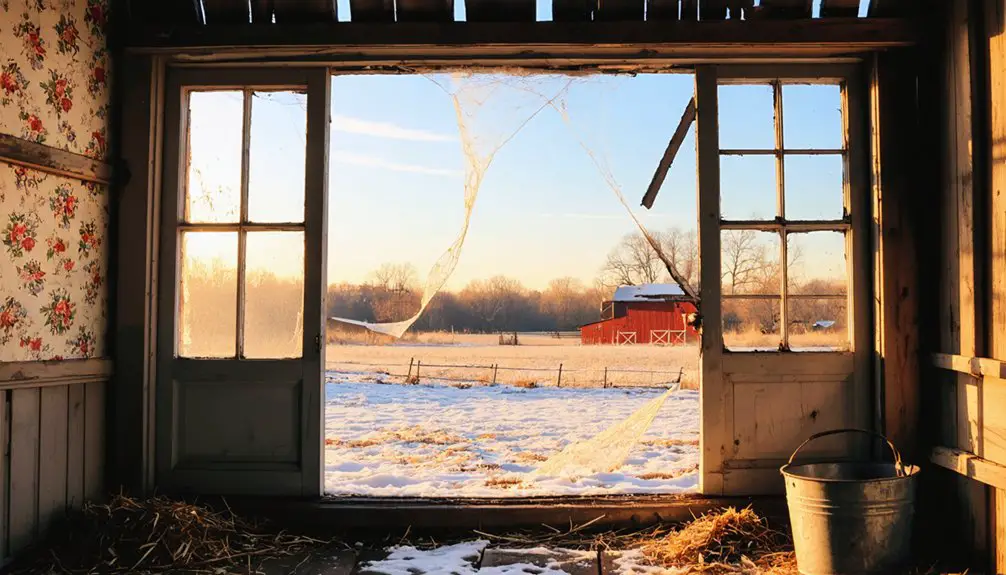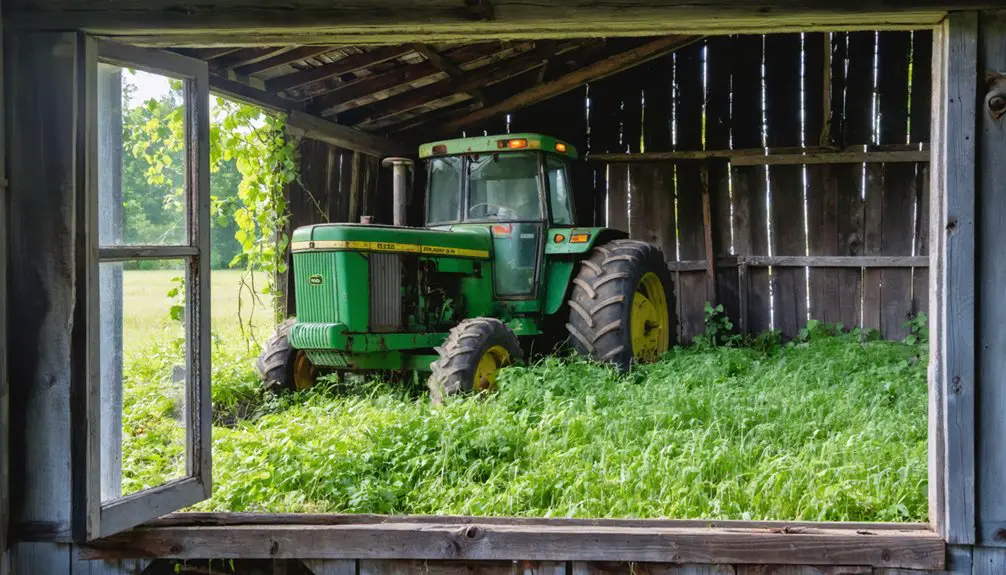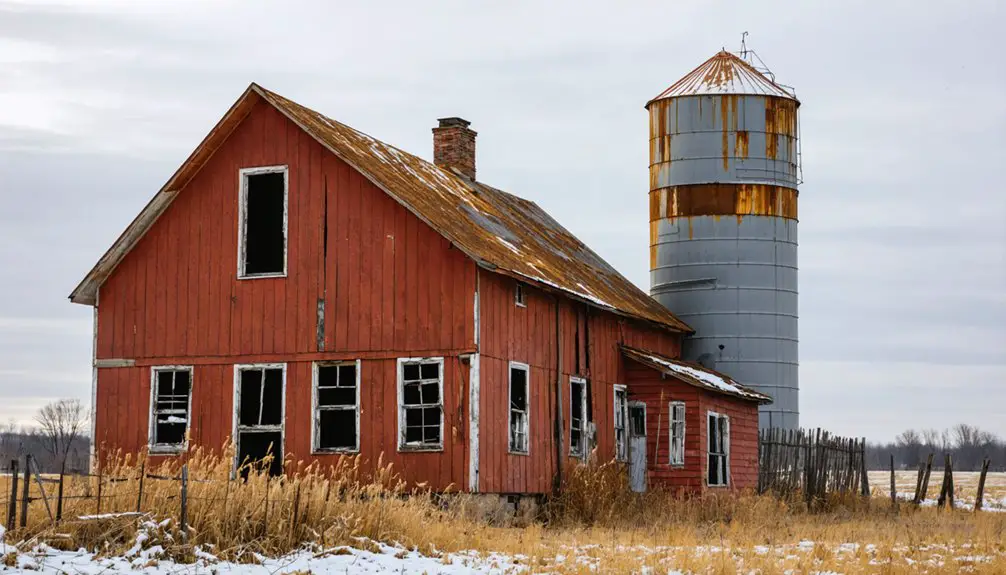You’ll find Smith Family Farms‘ ghost town remnants scattered across Vermont’s West Hill, where Asael Smith first purchased 83 acres in 1791. Through generations, the farm expanded to 400 acres of cleared forest, featuring a thriving maple operation and multiple homesteads. By the mid-1800s, changing transportation routes led to the community’s decline, leaving only moss-covered foundations and stone walls. Today’s preserved archaeological sites reveal centuries of pioneer life waiting to be explored.
Key Takeaways
- West Hill community declined in the mid-1800s after road rerouting left farms isolated and ultimately abandoned.
- Three original Smith house foundations remain along woodland trails, revealing remnants of early 19th-century pioneer settlement.
- The emergence of railroads between 1848-1861 isolated West Hill, causing significant population decline and farm abandonments.
- Archaeological evidence includes stone walls, building foundations, and domestic artifacts that document the area’s former farming community.
- Natural reforestation has transformed abandoned farmland, with native forests and wildlife now dominating the former settlement areas.
Early Settlement and Pioneering Days
When Asael Smith purchased 83 acres of uncleared land in Tunbridge, Vermont in 1791, he laid the foundation for what would become the Smith family’s agricultural legacy. His sons Jesse and Joseph immediately tackled the pioneering challenges, clearing dense forest and building a modest 14-by-10-foot hut that would shelter them through their first winter.
You’ll find that their settlement lifestyle reflected true frontier grit. The family transformed wild terrain into productive farmland, living in a smoky one-story log house with just two rooms and a low garret. The Smiths demonstrated remarkable skill in constructing fences and outbuildings, completing major improvements within their first five years of settling. Their son Joseph Jr. was born in Sharon, Vermont in 1805, adding another pioneering spirit to their growing family.
They expanded their holdings rapidly, growing from 83 to nearly 400 acres by 1802. Their homestead evolved to include a barn, cooper’s shop, and various outbuildings, while they established orchards and maple groves that yielded up to 1,000 pounds of sugar annually.
The Rise and Fall of West Hill Community
You’ll find that West Hill’s story begins around 1780, when land speculators carved out 100-200 acre lots from virgin forest near Mount Horrid.
By 1812, the construction of new roads finally connected the isolated agricultural community to neighboring areas, though these same transportation changes would later spell trouble. The area featured rolling farmland similar to what can still be found in West Havens today. Early settlers constructed stone walls throughout the region for sheep farming.
The rerouting of major roads away from West Hill by the mid-1800s triggered the community’s decline, leading families to abandon their farms as trade and accessibility dwindled.
Early Settlement Days
The vast wilderness of West Hill underwent a dramatic transformation in 1780 when 81 proprietors purchased large tracts of 100-200 acres each, though most were speculators rather than settlers.
You’d find the real settlement strategies emerged when families like the Smiths began claiming the virgin forest, turning untamed land into productive farms through sheer determination.
The Smiths exemplified the pioneering spirit, clearing 30 acres in their first year alone and expanding to control 300-400 acres by 1802. During this period, the family experienced both hardship and loss when their failed storekeeping venture led to the forfeiture of their farm and wedding gifts to settle mounting debts.
Their family dynamics centered on cooperation and strict economy as they built log homes, barns, and a thriving sugar maple operation. Joseph Smith Sr. and Lucy Mack Smith’s marriage in Tunbridge in 1796 marked a significant milestone in the family’s establishment.
You’ll appreciate how they managed to tap 1,200-1,500 trees annually, producing 1,000 pounds of sugar while maintaining extensive orchards and fenced fields despite frequent relocations driven by economic pressures.
Transportation Changes Impact
Since Vermont’s railroads emerged between 1848-1861, West Hill’s fate took a dramatic turn as its remote location left it disconnected from the new transportation networks.
The transportation evolution bypassed this upland community, leaving it dependent on overgrown cart paths while other Vermont towns prospered from rail connectivity.
The Crown Point Road served as a vital transportation route before railways rendered it obsolete.
You’ll find three pivotal shifts that shaped West Hill’s decline:
- Railroad development isolated farms by shifting trade routes away from traditional roadways
- Loss of wagon traffic diminished economic opportunities for remote agricultural families
- Mid-20th century interstate construction further severed rural connectivity, accelerating farm closures
The construction of Interstate 91 in the 1960s forced many farmers off their land through eminent domain, permanently altering Vermont’s rural landscape.
What you’re seeing in West Hill’s story reflects a broader pattern across Vermont’s countryside.
As transportation priorities changed, communities without direct rail or highway access gradually transformed from thriving farming centers into abandoned landscapes.
Agricultural Community Dispersal
Beyond transportation changes, economic pressures transformed West Hill’s agricultural landscape between 1840-1890, marking a period of dramatic community dispersal.
You’ll find that traditional family farms struggled to adapt as self-sufficient operations gave way to market-driven production. The rise of Merino sheep farming offered temporary prosperity before its eventual decline. Many original settlers’ farms were abandoned, particularly those distant from villages and railroads.
Yet some farms found economic adaptation strategies that worked – the Blood family successfully shifted to commercial production, while the McLaughlin family showed how immigrant farming practices could revive struggling properties.
You’ll notice that successful farms were typically those near transportation routes or those that embraced new agricultural methods.
Agricultural Transformation Through Generations
You’ll find that Chester M. Smith’s 1847 purchase of the 240-acre Rochester farm marked the beginning of significant agricultural development, as only four acres were initially cleared for farming.
The farm’s transformation continued through generations of the Smith family, who gradually shifted from traditional dairy and sheep operations to focus on sustainable grass-fed beef production. Willard “Jeff” and Mary Smith represent the seventh generation managing the historic property.
The operation’s evolution reflects Vermont’s changing agricultural landscape, with the farm adapting its practices while maintaining its maple sugaring heritage since the 1790s.
Early Land Clearing Challenges
When Vermont’s early settlers began clearing land in the late 18th century, they encountered formidable challenges that would shape the state’s agricultural landscape for generations. You’d have faced dense forests, rocky soil, and primitive tools as you struggled to carve out a living from the wilderness.
Land clearing reached its peak during the “Merino Mania” of the early 1800s, when farmers transformed nearly 80% of Vermont’s forests into sheep pastures.
- Your wooden plow would’ve splintered against Vermont’s stubborn soil until iron plows finally gained acceptance in the 1830s.
- You’d witness the ecological impact as white pine colonized cleared areas, often succumbing to disease.
- Your hard-won farmland would show nature’s scars, taking generations of trees to heal without proper management.
Dairy to Beef Evolution
The Smith Family Farm‘s agricultural legacy entered a pivotal chapter in 2005 as economic pressures forced tough decisions about its dairy operation.
You’ll find that their dairy conversion began in 2006 when they sold their dairy cows and purchased eight Hereford cattle, marking the start of their beef production journey.
The farm’s strategic shift paid off as their herd grew to 90 cattle, including 30 brood cows, 24 calves, and 35 feeders.
They’ve focused on Hereford and Angus/Hereford crosses, breeds that thrive in Vermont’s climate and excel in grass-fed programs.
Through intensive rotational grazing practices established since 1980, they’ve maintained healthy pastures while reducing costs.
This transformation reflects broader changes in Vermont’s agricultural landscape, where family farms are adapting to new market demands while preserving their farming heritage.
Lost Buildings and Forgotten Structures

Once thriving with activity, Smith Family Farms now stands as a collection of scattered stone remnants and building foundations across multiple locations.
You’ll find lost foundations of three original houses along woodland trails, while the second Smith Farm, abandoned by 1830, reveals hidden remnants preserved by the LDS Church.
In Rochester, moss-covered stone foundations mark where the Chester M. Smith farm’s buildings once stood.
- Stone-lined cellar holes and flat-topped mounds whisper stories of Vermont’s determined early settlers
- Granite barn foundations remind you of resourceful farmers who used local materials
- Faint footpaths through the woods trace the daily routes of those who came before
These surviving features paint a picture of labor-intensive farmstead development in upland Vermont’s challenging terrain.
Archaeological Evidence and Historical Findings
Since archaeological investigations began at Smith Family Farms, researchers have uncovered a complex layering of historical evidence spanning multiple centuries.
You’ll find archaeological artifacts ranging from domestic tools to building materials that reveal daily life patterns of the Smith family, while historical documents like deeds and account books track their farming operations and economic activities.
The site’s most intriguing features are the stone mounds, which you can’t definitively attribute to farm clearing. These structures might predate the Smiths’ 1780 arrival, possibly serving Native American purposes.
Through extensive excavations, researchers have documented everything from drumlins to wetlands, while household items help verify construction dates of farm buildings.
The combined evidence paints a vivid picture of early Vermont farm life and prehistoric land use.
Nature’s Reclamation of Former Farmlands

After generations of agricultural use and archaeological study, Smith Family Farms has undergone a remarkable natural transformation.
You’ll witness nature’s recovery as native forests gradually reclaim the land, with birch and aspen giving way to mature hardwoods like maple and oak. The ecosystem balance has restored itself through improved soil conditions, enhanced wildlife habitats, and restored water cycles.
- Former fields now burst with diverse plant life, while moss and ferns embrace old stone walls.
- Wildlife corridors have reformed, bringing deer, foxes, and countless bird species back home.
- Natural wetlands have expanded in low-lying areas, creating sanctuaries for amphibians and aquatic life.
You can explore these regenerating spaces through recreational trails, where nature’s resilience is on full display as abandoned structures become wildlife shelters and former farmland transforms into thriving forest.
Preserving the Legacy of Lost Communities
Through dedicated preservation efforts, Smith Family Farms stands as a tribute to Vermont’s rich historical legacy.
You’ll find local historical societies working tirelessly on community preservation projects, restoring original structures and creating educational spaces that tell the farm’s story. Historical documentation efforts have gathered photographs, documents, and oral histories from former residents to maintain the site’s cultural significance.
Local historians preserve our past by restoring historic buildings and collecting stories that keep our heritage alive for future generations.
You can join volunteer groups that maintain trails, create interpretive signage, and assist with hands-on restoration work.
The site’s protection is guaranteed through state preservation laws and conservation easements, while educational programs help you understand the social and economic factors that shaped the farm’s history.
Through partnerships with schools and museums, Smith Family Farms continues to educate future generations about Vermont’s agricultural heritage.
Modern Day Exploration and Discovery
Modern visitors to Smith Family Farms can explore three original house foundations along maintained woodland trails in Sharon, Vermont.
You’ll discover hearth stones and cellar holes that reveal the daily lives of early 19th-century settlers. The visitor center provides interpretive materials to enhance your understanding of this historic site, while seasonal activities like Christmas light displays bring the property to life during winter months.
- Stand where the Smith family once lived as you examine authentic historical artifacts including stone-lined foundations and an original bridge.
- Walk freely through the preserved grounds at 1,900 feet elevation, imagining life on the frontier before roads existed.
- Connect with Vermont’s pioneer history through self-guided exploration of archaeological remains and educational exhibits.
Tales From the Abandoned Homesteads
The tales of Smith Family Farms trace back to two abandoned homesteads that once thrived in Vermont’s rural landscape. You’ll find more than just ghost stories here – these properties tell the saga of the Smith and Mack families who carved out a living from the wilderness, clearing just four acres initially.
While family legends often focus on Joseph Smith’s birth at the first farm, you’ll discover a deeper narrative of rural Vermont life through Chester Smith’s detailed records from 1838-1847.
Beyond tales of Joseph Smith’s birthplace, Chester Smith’s farm records reveal the authentic rhythms of 1800s Vermont agricultural life.
The farms’ transformation from working homesteads to abandoned foundations mirrors countless Vermont families’ struggles.
Today, you can walk the wooded trails past crumbling stone walls where three houses once stood, witnessing how these properties evolved from active farms to historic landmarks preserved by the LDS Church.
Frequently Asked Questions
Are There Any Reported Paranormal Activities at the Abandoned Smith Farm Sites?
Like a blank canvas, you won’t find documented ghost sightings at these sites, despite Vermont’s rich history of haunted locations. No specific paranormal activities have been officially reported there.
What Happened to the Original Smith Family Cemetery From the 1780S?
You’ll find the original 1780s cemetery’s history remains unclear – its legacy obscured by time, poor documentation, and changing land use. Modern farming likely integrated or covered the burial grounds entirely.
Did Any Smith Family Members Leave Behind Buried Treasures or Time Capsules?
You won’t find buried artifacts or hidden heirlooms from the Smith family – historical records, archaeological surveys, and local lore don’t support any claims of deliberately concealed treasures at these locations.
Were There Connections Between Smith Farms and the Underground Railroad Movement?
While direct proof remains elusive, you’ll find strong regional Underground Railroad activity and documented Smith family abolitionist connections nearby in Keeseville, NY, suggesting possible involvement at the Vermont location.
What Native American Artifacts Have Been Discovered on Former Smith Farmlands?
You’ll find Native artifacts of high historical significance at these farmlands, including quartz-incorporated stone mounds, a distinct crescent-shaped cairn, and potentially clay pottery pieces similar to regional finds.
References
- https://smithfamilymeats.com/the-farm/
- https://vermontjournal.com/arts-entertainment/a-vermont-family-farm-for-225-years/
- https://neara.org/pdf/Smith_Site.pdf
- https://history.churchofjesuschrist.org/content/historic-sites-palmyra-vermont-new-york?lang=eng
- https://rsc.byu.edu/joseph-smith-prophet-man/joseph-smith-sr-family-farmers-genesee
- http://www.fullerconsideration.com/sources.php?cat=PBOM-DOM
- https://josephsmithjr.org/tunbridge-vermont-the-beginning-of-the-joseph-smith-family/
- https://obscurevermont.com/ghost-hollow/
- https://vermontcountry.com/2022/09/18/ghost-town/
- http://freepages.rootsweb.com/~gtusa/history/usa/vt.htm



